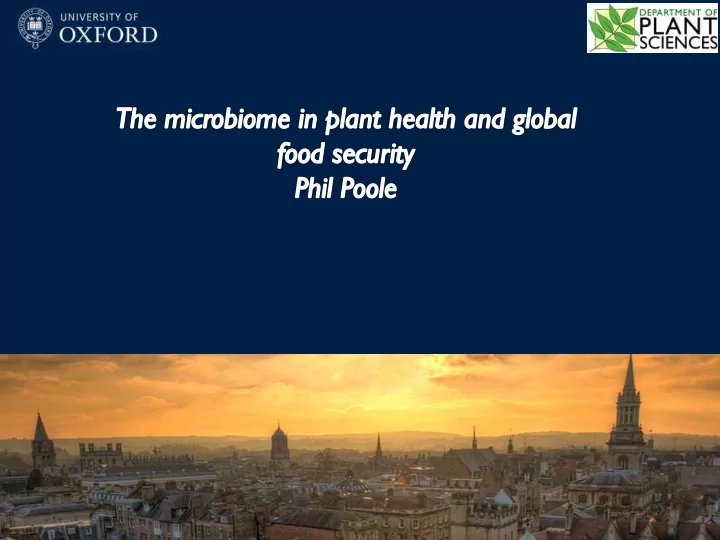

Soil/Rhizosphere • Microorganisms are responsible for most nutrient transformation in soil. • 10 9 cells and 10 6 distinct taxa per g of soil. • Different plants have different root exudates (up to 20% of photosynthate). • Arabidopsis does not grow in g- irradiated soil
From the first land plants to cereals and legumes • First land plant used AM fungi as rooting systems • Legume Family (Leguminosae) 3 rd largest family of plants 19,400 species • Legumes have symbiosis with bacteria (the rhizobia)
From the first land plants to cereals and legumes • First land plant used AM fungi as rooting systems • Legume Family (Leguminosae) 3 rd largest family of plants 19,400 species • Legumes have symbiosis with bacteria (the rhizobia)
The Players + = Bradyrhizobium Soybean N 2 fixation in nodules japonicum Soybeans twice protein per acre as any other major vegetable or grain crop, 5 to 10 times than land used for dairy, and 15 times land for meat production.
Nitrogen cycle • Nitrogen cycles between inert N 2 and biologically available NH 3 • Nitrogen main limiter of biological production • 50-60% of biospheres nitrogen comes bacterial N 2 fixation in legume nodules
Pisum sativum • 7 chromosomes diploid 5 Gbp (human 3.2 Gbp) • Mendel examined 7 traits on 4 chromosomes • Bateson championed Mendel’s work and coined Genetics
European civilisation and legumes • Umberto Eco considers the bean saved Western civilisation (New York Times) • From 1000-1500AD Europe's population tripled because of bean cultivation (Animal manure not sufficient)
Oil of the 19 th century • Chincha Islands Guano • War of the Pacific 1879-1883
Greatest Scientific development in last 200 years? “It is the chemist who must come to the rescue of the threatened communities“ Sir William Crookes 1898 to BAAS N 2 (g) + 3H 2 (g) ⇌ 2NH 3 (g), ΔH = −92.4 kJmol -1 CH 4 + H 2 O → CO + 3H 2 • Haber discovered 1909 Nobel prize 1918 • Bosch scaled up and won Nobel in 1931
Nitrogen and population • Addition of nitrogen and phosphorous: Haber Bosch process 1909 • Dwarf varieties of wheat and rice (short stem, large grain): Green revolution 1960’s
Nitrogen cascade • Massive application of Haber-Bosch Nitrogen for agriculture (120 Mt year) • Reactive Nitrogen in biosphere now 2X pre-industrial level • Nitrate leaches to ground water • Denitrifiers convert excess soil ammonia to N 2 O (nitrous oxide) • N 2 O 300X more potent greenhouse gas than CO 2
Rockstrom et al. Nature 2009: 473
Global grain yields
Nutrient limitation A=maize B=wheat C=rice Mueller et al. Nature 490 , 254 (2012)
We have a problem
Nitrogen cycle • Nitrogen cycles between inert N 2 and biologically available NH 3 • 50-60% of biospheres nitrogen comes bacterial N 2 fixation in legume nodules • Nitrogen main limiter of biological production
Getting inside a nodule Gage and Margolin Current Opinions in Microbiology 2000, 3 : 613-617
Nodulation signalling pathway (shared with mycorrihzal fungi) Nod Factor Nod Gene Ca ++ induction spiking LRR-kinase TFs Cation channel Receptors CCaMK Nucleoporins TFs Myc Gene induction Myc Factor
The exchange that limits life CO 2 Oxaloacetate PEP Hexoses Malate H + ATP ADP + Dct? Acetyl-CoA DctA P i Fen1 Aap α -ketoglutarate Homocitrate H + ? Bra H + H + Pyr Ala Acetyl- ? PH CoA Amino acid Asn B Nitogenase Glu pool OAA e - & ATP complex GS/ H + AS GOGAT TCA GS Ile N 2 NH 3 NH 4 Gln cycle Leu Aap + Val Bra Bac ? Sst1 A Mol 2- SO 4 ? MgtE ER ? ? nucleus Dmt1 golgi 2 MoO 4 2 Mg NCR - 2+ Fe + SPC Symbiotic plant cell Udvardi and Poole, Downie Annu Rev Plant Biology (2013)
ENGINEERING SYNTHETIC SYMBIOSES • Engineer tailored nitrogen-fixing plant microbe associations using established endophytic plant microbes • Engineer nodules onto cereals • Express nitrogenase in plant plastids
Natural solutions • Eat legumes not meat and dairy • Improve use and efficiency of legumes
Beans in Africa
Problem with beans • Beans in Africa get nodulated by rhizobia that fix little nitrogen • How can we identify the good nitrogen fixing bacteria?
Glowing bacteria light up nodules • nifH::luxCDABE fusion in pea/bean nodulating bacteria • Bacteria glow when they fix N 2, i.e. report how effective
Acknowledgements • Vinoy Ramachandran • Alison East • Izzy Webb • Jason Terpollili • Kushboo Boorah • Rachel Wheatley • Barney Geddes • Amelie Joffrin • Ponraj Paramasivan (Cambridge) • Nick Kruger • George Ratcliffe • Stuart Conway • Giles Oldroyd (Cambridge)
Recommend
More recommend